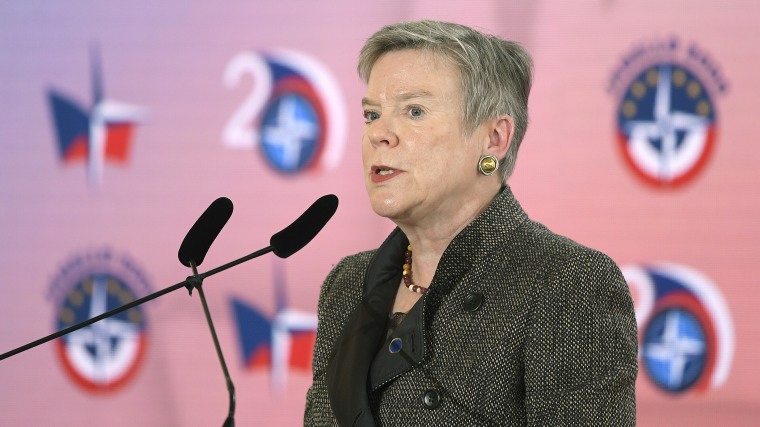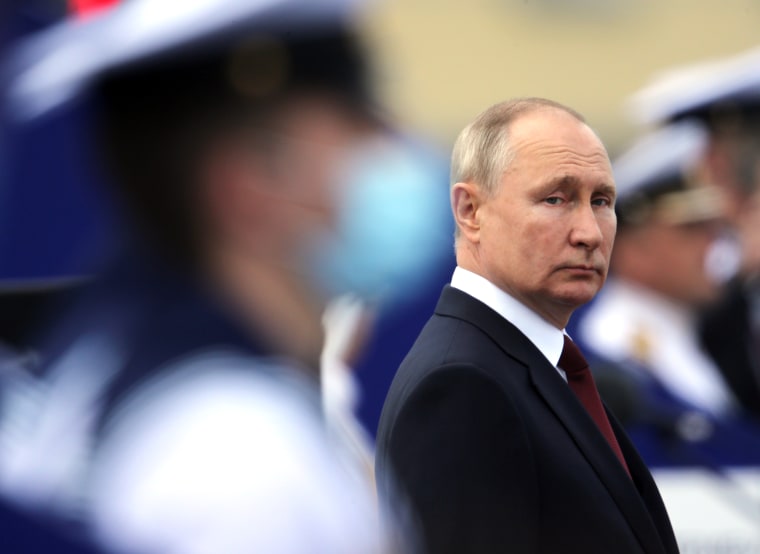Russian President Vladimir Putin’s move to suspend his country’s involvement in the last remaining arms control treaty with the U.S. came as a disturbing surprise to multiple former officials who negotiated the pact and nonproliferation experts committed to ending the expansion of nuclear forces.
For more than 50 years, the U.S. and Russia — the world’s two largest nuclear powers — have had some form of an agreement in place that capped their ability to produce or deploy nuclear weapons. Putin’s announcement that he was suspending participation in the New START Treaty could end that era, with some of those experts debating whether this could launch another Cold War-style arms race. Tensions between the two nations over the war in Ukraine only increases those concerns.
“Putin’s clearly trying to inject nuclear leverage into both Ukraine and his relationship with the United States,” said Jon Wolfsthal, who helped negotiate the New START Treaty in 2009 as a member of the National Security Council. “And that should worry a lot of people.”
While Putin maintained in his speech Tuesday that Russia would not be the first to use a nuclear weapon, Russia has rattled its nuclear saber multiple times since the start of the war, referencing its nuclear capabilities and threatening Ukraine’s nuclear power plants with bombs and shells. Secretary of State Antony Blinken told reporters on Tuesday that the U.S. is keeping a watchful eye on how the situation develops and is open to further talks.
“We remain ready to talk about strategic weapons limitations at any time with Russia, irrespective of anything else going on in the world or in our relationship,” Blinken said.
What is New START, and how frequent were inspections?
The New START treaty was signed in Prague in 2010 as a continuation of the Strategic Arms Reduction Treaty, which had expired the previous year and oversaw a drawdown of nuclear forces between the two superpowers in the 1990s. The Obama-era agreement put further limits on American and Russian nuclear stocks from the initial treaty.
The number of deployed warheads — warheads that are placed on missiles or in military bases with operational forces — was capped at 1,550 and there are additional ceilings on the individual number of deployed missiles, bombers and launchers as well.
To ensure the level of stocks, the two countries have conducted 328 on-site inspections, more than 25,000 notifications regarding the status of nuclear delivery vehicles and launchers, and 19 bilateral meetings, according to the State Department.
Within President Joe Biden’s first month in office, he reached an agreement with Putin to extend New START for five years. (It had been set to expire in February 2021, after the Trump administration failed to hammer out an agreement.) Just last year, the U.S. and Russia committed to creating a new agreement “to achieve deeper, irreversible, and verifiable reductions in their nuclear arsenals,” according to a joint statement.
That commitment came despite Russia’s continued postponement of on-site inspections, which were suspended due to the pandemic, and increased tensions between the two countries since Putin’s decision to invade Ukraine in February 2022. The State Department told Congress earlier this month that Moscow’s resistance to on-site inspections — the last was conducted in March 2020 — had put it in a position of noncompliance with the treaty.
Putin’s clearly trying to inject nuclear leverage into both Ukraine and his relationship with the United States.
-Jon Wolfsthal, former NSC official who helped negotiatE NEW START
In his speech on Tuesday, Putin suggested that the U.S. would share information about Russia’s nuclear facilities with Ukraine while calling a full return to the treaty “absurd.” Despite ending its adherence to inspections, the Russian Foreign Ministry said Tuesday the country intends to observe and adhere to the limits “within the life cycle” of the arms control treaty, which is set to expire in 2026.
“Our reliance on that treaty has been right,” said Wolfsthal, now a senior adviser to Global Zero, a group working toward the elimination of nuclear weapons, and a member of the Bulletin of the Atomic Scientists' Science and Security Board. “But now we need to come up with new strategies, whether that is diplomatic, deterrent, conventional or even nuclear. We’re in new territory we haven’t seen for 50 years.”
But not all agreed with the assessment.
John Bolton, who served as national security adviser during the Trump administration, said he viewed New START as a bad deal. “If it disappeared tomorrow, it wouldn’t trouble me at all,” he said.
China, he added, should be the main concern, and the New START agreement only served to cap Washington and Moscow’s capabilities, not Beijing’s.
“As China raises its production and delivery capabilities, you’re in a tripolar nuclear world,” Bolton said. “And it would be foolhardy for the United States to engage in a treaty of limitations with one of those other major nuclear powers but not the other.”
Does a ‘suspension’ mean Russia has pulled out of the treaty?
Russia’s decision to suspend the treaty is of “questionable legality,” Rose Gottemoeller, a former State Department senior official who served as chief negotiator of New START during the Obama administration, said in an email. “The treaty contains no right to do so,” she added.

But that does not necessarily mean the agreement is at an end. Though there is no enforcement mechanism or legal provision under the treaty for suspension, the Vienna Convention allows countries to suspend these types of agreements under extraordinary circumstances, which Russia would likely claim as the U.S. regularly aids and communicates with Ukraine in the ongoing war.
Russia’s suspension of the treaty and the lack of on-site inspections also does not yet put it in material breach of the agreement, as long as it caps its deployed warhead number, according Wolfsthal.
If Russia were to increase beyond that cap, U.S. officials would be required to notify Congress and countermeasures would likely be taken to ensure the U.S. is “not at a military or strategic disadvantage,” Wolfsthal said.
“This is designed to unsettle us,” Wolfsthal added of Putin’s announcement. “The question will be whether the United States and its allies take the bait.”
To some, however, Russia’s suspension was enough to end the agreement altogether.
“If you stop complying with the terms of an agreement, that is perfectly good grounds for another party to the agreement to say, ‘Well, now you’re in violation, and I consider my obligations to be null and void,’” Bolton said.
Putin’s history of ‘suspending’ arms agreements
This is not the first time Putin has suspended an arms agreement. Many former officials and nonproliferation experts recalled Putin’s announcement in 2007 that the Kremlin would suspend the Treaty on Conventional Armed Forces in Europe, which was signed in the final year of the Cold War.
The Russians ultimately withdrew from that agreement in 2015, alleging NATO’s expansion to the Baltic states and Slovenia undermined the terms of the pact.
“Russia just has a bad, bad track record on this,” Hans Kristensen, the director of the Nuclear Information Project at the Federation of American Scientists, said.
Kristensen noted that the Intermediate-Range Nuclear Forces Treaty, a landmark agreement that was signed during the Reagan administration, also came to an end in 2019. Trump pulled out of the agreement citing Russian noncompliance as the key reason to end the 30-year-old commitment.
“The lid blew off that one and it’s gone,” Kristensen said. “So now here we are with the last treaty. It’s really an astoundingly quick sabotage of the international arms control regime that we have seen in play here under Putin.”
Will this spur an arms race?
Whether Russia’s suspension of New START will usher in the next arm’s race is an open question, despite the Kremlin’s assurances on Tuesday that it intends to adhere to the broad strokes of the agreement, at least until its expiration date in 2026.
Jeff Edmonds, who served on the National Security Council in the Obama administration leading Russia policy, said that Russia has greater breakout capabilities than the U.S. — in that it has a greater number of nonstrategic nuclear warheads that it could put on missiles. Those warheads are designed for a battlefield with friendly forces in close proximity. But affixing those warheads to missiles would be a significant amount of work.
Edmonds said it wouldn’t make much sense for Russia to undertake that effort given the sizable cost and the many nuclear weapons Russia already has in its possession.
“We currently have enough to wipe each other off the globe,” he said of the two country’s capabilities.
“These things are not cheap to create or maintain,” Edmonds added. “So I’m not sure what the actual strategic benefit is if the Russians start cranking out a bunch of new nuclear arms.”
The U.S., meanwhile, is modernizing its nuclear forces, availing itself of greater flexibility as it works on new missile types and tubes with an aim to outperform Russia and China.
But all this does not necessarily portend a sudden arms race.
Bolton, asked about the suggestion that the end of New START might lead to an arms race, facetiously asked, “With who?”
An arms race, some experts pointed out, would not be in either Russia or U.S. interests.
“The problem for Putin is that he can only play this game so far because if the treaty totally falls away and conservatives in Congress manage to get approval to increase the number of deployed (nuclear) forces, then Putin will be faced with more American weapons pointed at him,” Kristensen said. “And that wouldn’t be in his or our interest at all.”

